Abstract
Campylobacter hyointestinalis was isolated from stool specimens of four persons, all of whom were experiencing nonbloody, watery diarrhea. The youngest (8 months of age) and the oldest (79 years of age) individuals were females, and the other two were homosexual men. C. hyointestinalis was the only clinically significant pathogen isolated from stool specimens for three of the individuals. In case 3 (involving a 37-year-old homosexual man), Entamoeba histolytica and Shigella sonnei were also present in the stool. The identification of all C. hyointestinalis strains was made biochemically and confirmed by DNA hybridization. This study documented the isolation of C. hyointestinalis from four patients with diarrhea, and our findings suggest that the clinical significance of Campylobacter species must be expanded to include C. hyointestinalis as a potential cause of human gastrointestinal disease.
Full text
PDF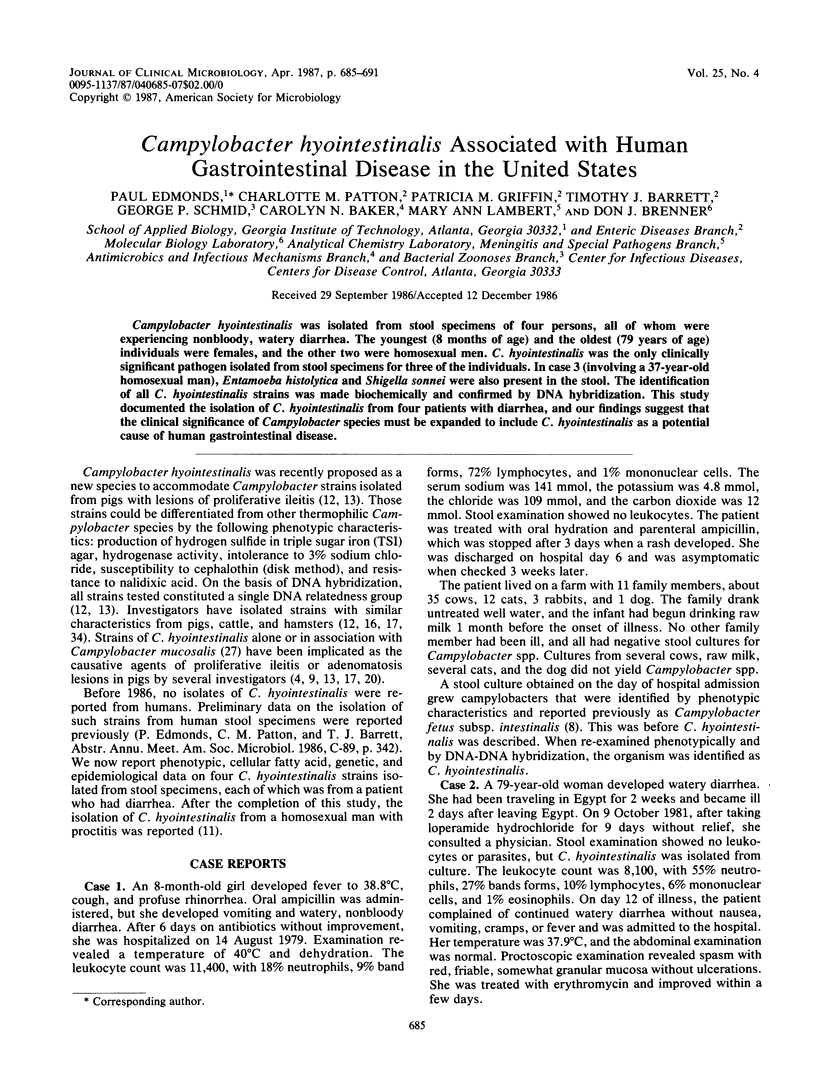
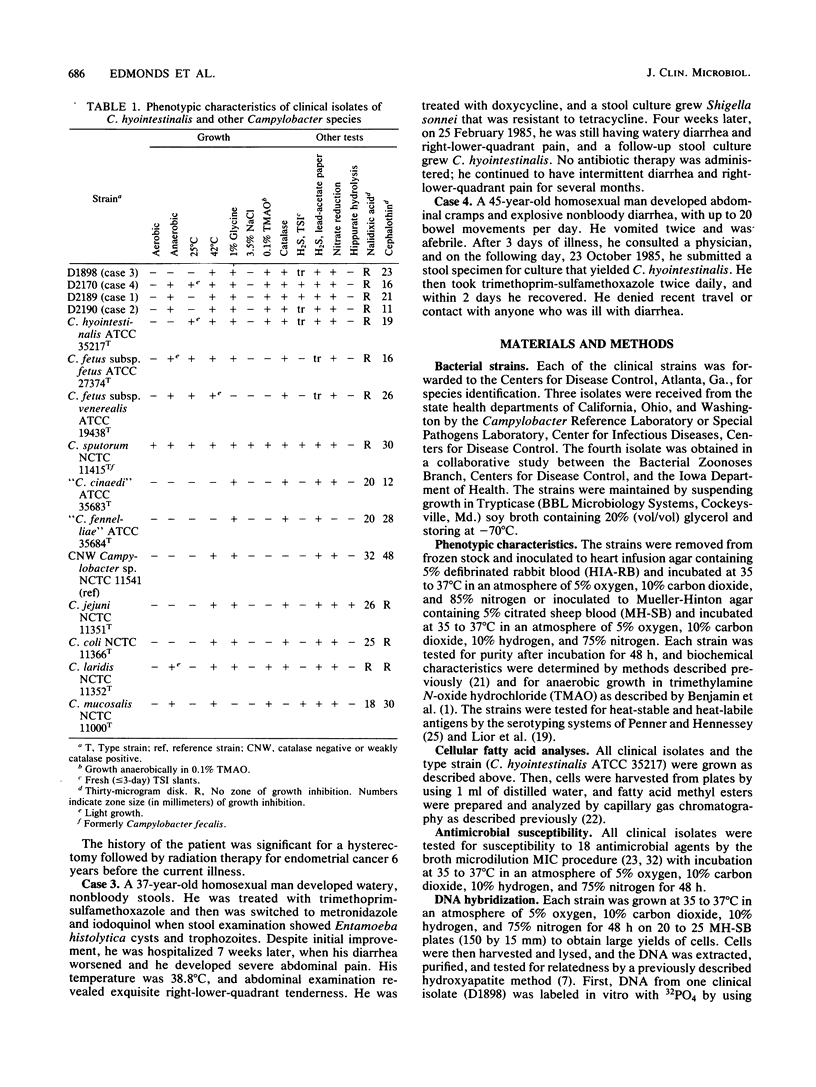
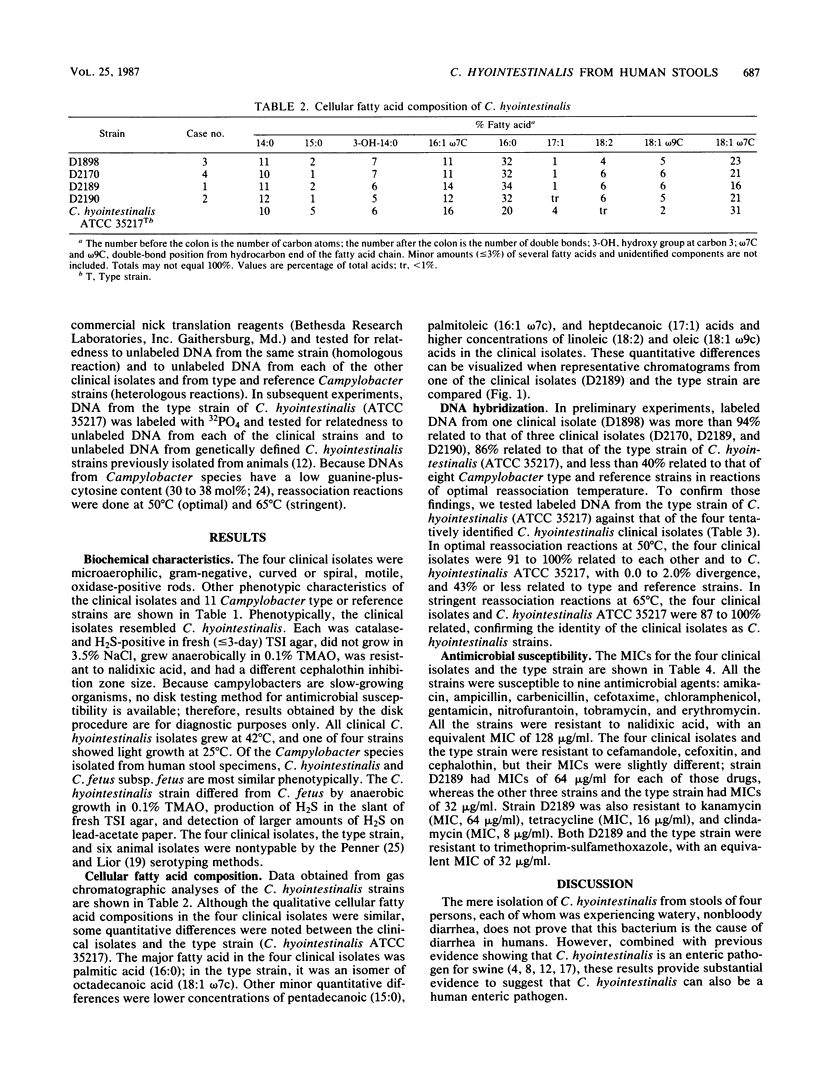
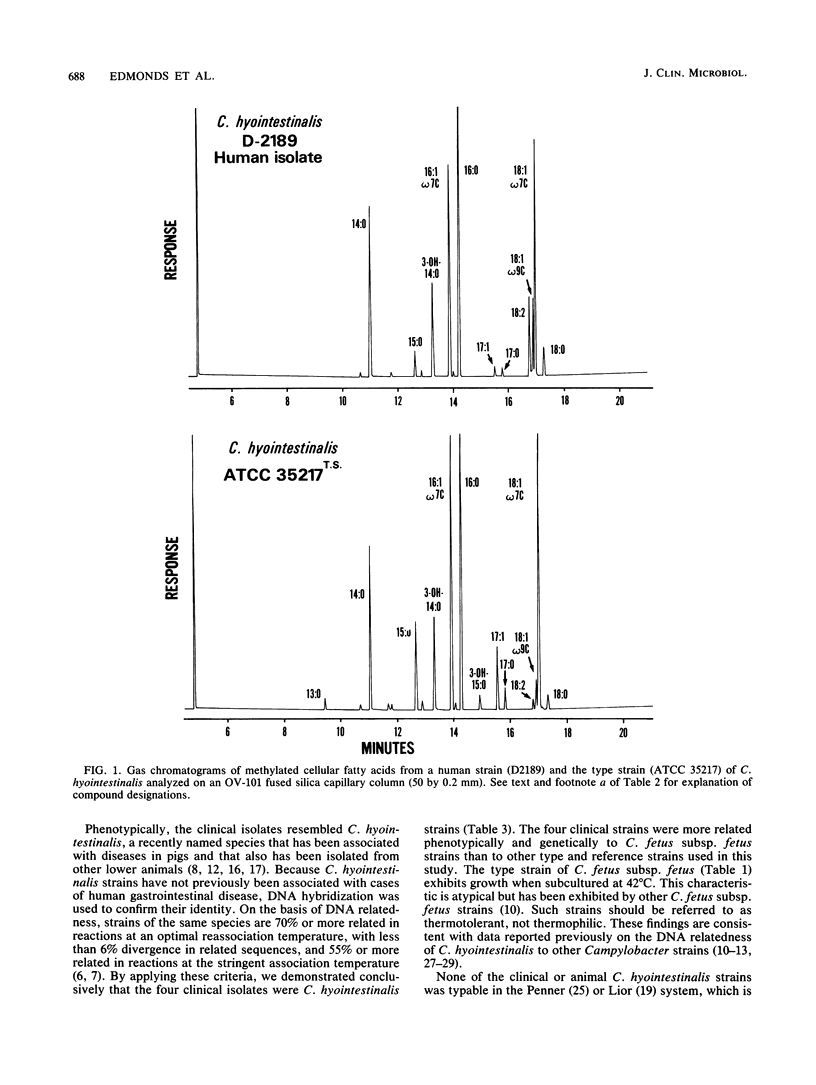
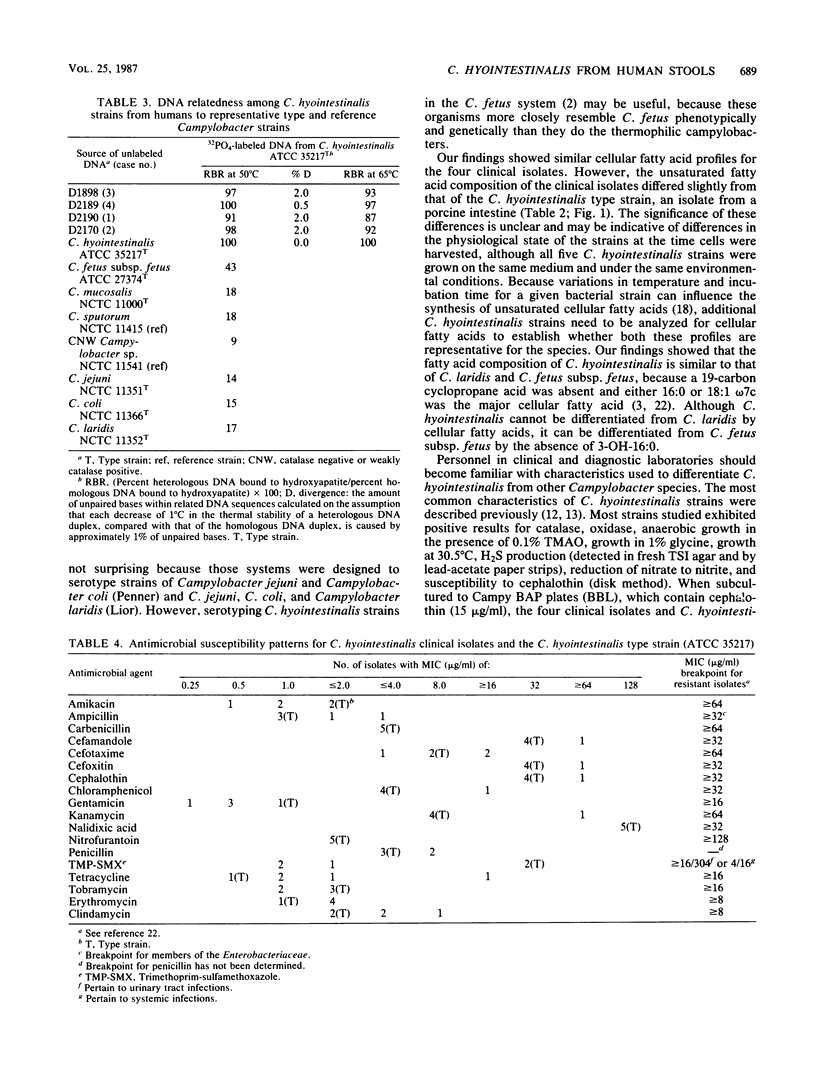
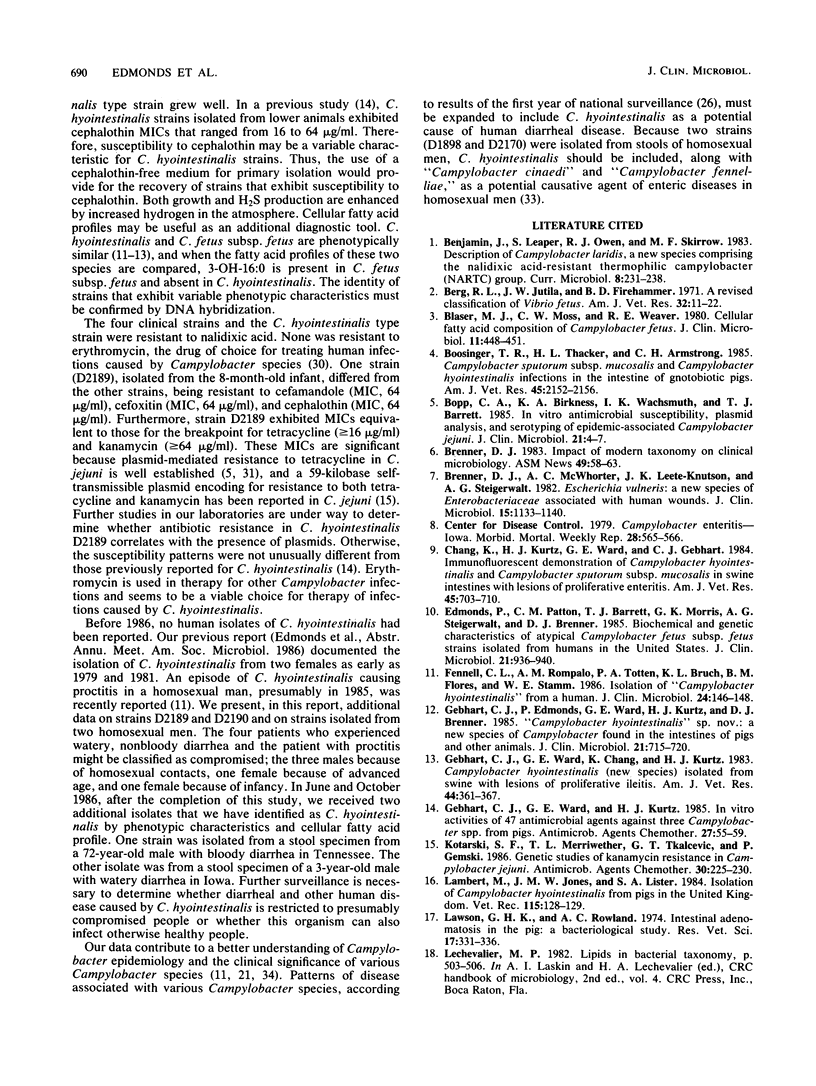
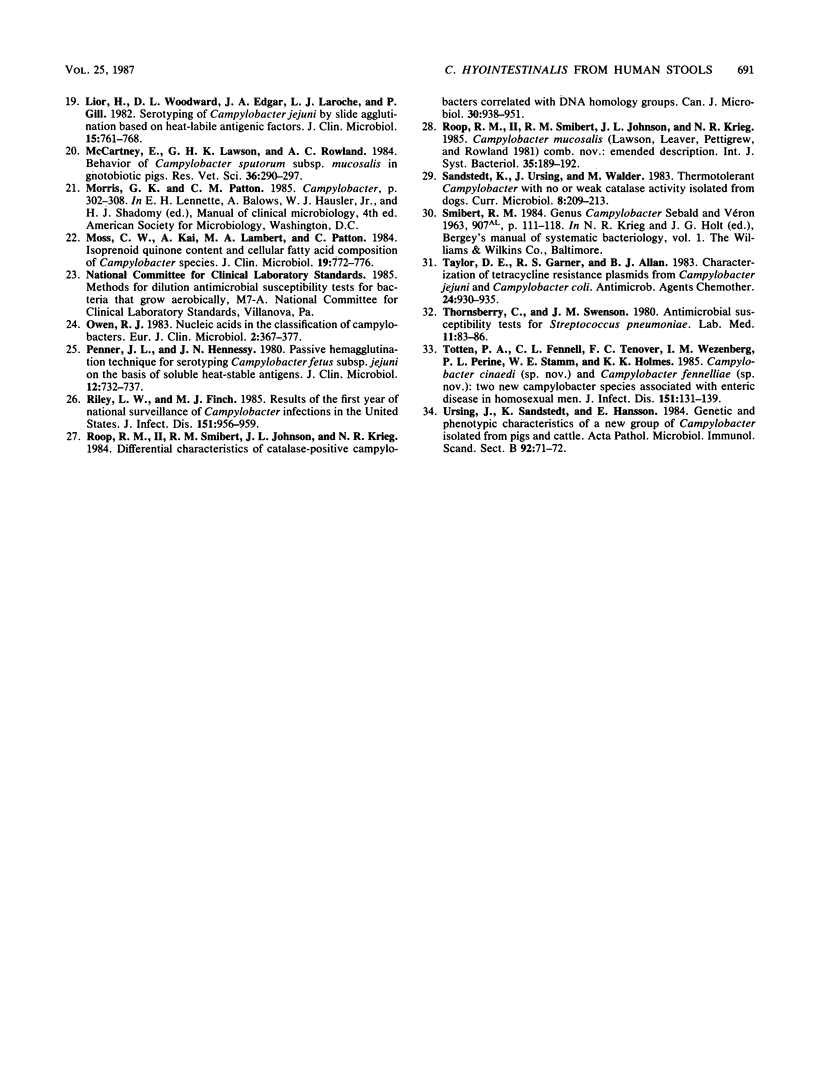
Selected References
These references are in PubMed. This may not be the complete list of references from this article.
- Berg R. L., Jutila J. W., Firehammer B. D. A revised classification of Vibrio fetus. Am J Vet Res. 1971 Jan;32(1):11–22. [PubMed] [Google Scholar]
- Blaser M. J., Moss C. W., Weaver R. E. Cellular fatty acid composition of Campylobacter fetus. J Clin Microbiol. 1980 May;11(5):448–451. doi: 10.1128/jcm.11.5.448-451.1980. [DOI] [PMC free article] [PubMed] [Google Scholar]
- Boosinger T. R., Thacker H. L., Armstrong C. H. Campylobacter sputorum subsp mucosalis and Campylobacter hyointestinalis infections in the intestine of gnotobiotic pigs. Am J Vet Res. 1985 Oct;46(10):2152–2156. [PubMed] [Google Scholar]
- Bopp C. A., Birkness K. A., Wachsmuth I. K., Barrett T. J. In vitro antimicrobial susceptibility, plasmid analysis, and serotyping of epidemic-associated Campylobacter jejuni. J Clin Microbiol. 1985 Jan;21(1):4–7. doi: 10.1128/jcm.21.1.4-7.1985. [DOI] [PMC free article] [PubMed] [Google Scholar]
- Brenner D. J., McWhorter A. C., Knutson J. K., Steigerwalt A. G. Escherichia vulneris: a new species of Enterobacteriaceae associated with human wounds. J Clin Microbiol. 1982 Jun;15(6):1133–1140. doi: 10.1128/jcm.15.6.1133-1140.1982. [DOI] [PMC free article] [PubMed] [Google Scholar]
- Chang K., Kurtz H. J., Ward G. E., Gebhart C. J. Immunofluorescent demonstration of Campylobacter hyointestinalis and Campylobacter sputorum subsp mucosalis in swine intestines with lesions of proliferative enteritis. Am J Vet Res. 1984 Apr;45(4):703–710. [PubMed] [Google Scholar]
- Edmonds P., Patton C. M., Barrett T. J., Morris G. K., Steigerwalt A. G., Brenner D. J. Biochemical and genetic characteristics of atypical Campylobacter fetus subsp. fetus strains isolated from humans in the United States. J Clin Microbiol. 1985 Jun;21(6):936–940. doi: 10.1128/jcm.21.6.936-940.1985. [DOI] [PMC free article] [PubMed] [Google Scholar]
- Fennell C. L., Rompalo A. M., Totten P. A., Bruch K. L., Flores B. M., Stamm W. E. Isolation of "Campylobacter hyointestinalis" from a human. J Clin Microbiol. 1986 Jul;24(1):146–148. doi: 10.1128/jcm.24.1.146-148.1986. [DOI] [PMC free article] [PubMed] [Google Scholar]
- Gebhart C. J., Edmonds P., Ward G. E., Kurtz H. J., Brenner D. J. "Campylobacter hyointestinalis" sp. nov.: a new species of Campylobacter found in the intestines of pigs and other animals. J Clin Microbiol. 1985 May;21(5):715–720. doi: 10.1128/jcm.21.5.715-720.1985. [DOI] [PMC free article] [PubMed] [Google Scholar]
- Gebhart C. J., Ward G. E., Chang K., Kurtz H. J. Campylobacter hyointestinalis (new species) isolated from swine with lesions of proliferative ileitis. Am J Vet Res. 1983 Mar;44(3):361–367. [PubMed] [Google Scholar]
- Gebhart C. J., Ward G. E., Kurtz H. J. In vitro activities of 47 antimicrobial agents against three Campylobacter spp. from pigs. Antimicrob Agents Chemother. 1985 Jan;27(1):55–59. doi: 10.1128/aac.27.1.55. [DOI] [PMC free article] [PubMed] [Google Scholar]
- Kotarski S. F., Merriwether T. L., Tkalcevic G. T., Gemski P. Genetic studies of kanamycin resistance in Campylobacter jejuni. Antimicrob Agents Chemother. 1986 Aug;30(2):225–230. doi: 10.1128/aac.30.2.225. [DOI] [PMC free article] [PubMed] [Google Scholar]
- Lambert M., Jones J. M., Lister S. A. Isolation of Campylobacter hyointestinalis from pigs in the United Kingdom. Vet Rec. 1984 Aug 11;115(6):128–129. doi: 10.1136/vr.115.6.128. [DOI] [PubMed] [Google Scholar]
- Lawson G. H., Rowland A. C. Intestinal adenomatosis in the pig: a bacteriological study. Res Vet Sci. 1974 Nov;17(3):331–336. [PubMed] [Google Scholar]
- Lior H., Woodward D. L., Edgar J. A., Laroche L. J., Gill P. Serotyping of Campylobacter jejuni by slide agglutination based on heat-labile antigenic factors. J Clin Microbiol. 1982 May;15(5):761–768. doi: 10.1128/jcm.15.5.761-768.1982. [DOI] [PMC free article] [PubMed] [Google Scholar]
- McCartney E., Lawson G. H., Rowland A. C. Behaviour of Campylobacter sputorum subspecies mucosalis in gnotobiotic pigs. Res Vet Sci. 1984 May;36(3):290–297. [PubMed] [Google Scholar]
- Moss C. W., Kai A., Lambert M. A., Patton C. Isoprenoid quinone content and cellular fatty acid composition of Campylobacter species. J Clin Microbiol. 1984 Jun;19(6):772–776. doi: 10.1128/jcm.19.6.772-776.1984. [DOI] [PMC free article] [PubMed] [Google Scholar]
- Owen R. J. Nucleic acids in the classification of Campylobacters. Eur J Clin Microbiol. 1983 Aug;2(4):367–377. doi: 10.1007/BF02019473. [DOI] [PubMed] [Google Scholar]
- Penner J. L., Hennessy J. N. Passive hemagglutination technique for serotyping Campylobacter fetus subsp. jejuni on the basis of soluble heat-stable antigens. J Clin Microbiol. 1980 Dec;12(6):732–737. doi: 10.1128/jcm.12.6.732-737.1980. [DOI] [PMC free article] [PubMed] [Google Scholar]
- Riley L. W., Finch M. J. Results of the first year of national surveillance of Campylobacter infections in the United States. J Infect Dis. 1985 May;151(5):956–959. doi: 10.1093/infdis/151.5.956. [DOI] [PubMed] [Google Scholar]
- Roop R. M., 2nd, Smibert R. M., Johnson J. L., Krieg N. R. Differential characteristics of catalase-positive campylobacters correlated with DNA homology groups. Can J Microbiol. 1984 Jul;30(7):938–951. doi: 10.1139/m84-147. [DOI] [PubMed] [Google Scholar]
- Taylor D. E., Garner R. S., Allan B. J. Characterization of tetracycline resistance plasmids from Campylobacter jejuni and Campylobacter coli. Antimicrob Agents Chemother. 1983 Dec;24(6):930–935. doi: 10.1128/aac.24.6.930. [DOI] [PMC free article] [PubMed] [Google Scholar]
- Totten P. A., Fennell C. L., Tenover F. C., Wezenberg J. M., Perine P. L., Stamm W. E., Holmes K. K. Campylobacter cinaedi (sp. nov.) and Campylobacter fennelliae (sp. nov.): two new Campylobacter species associated with enteric disease in homosexual men. J Infect Dis. 1985 Jan;151(1):131–139. doi: 10.1093/infdis/151.1.131. [DOI] [PubMed] [Google Scholar]
- Ursing J., Sandstedt K., Hansson E. Genetic and phenotypic characteristics of a new group of Campylobacter isolated from pigs and cattle. Acta Pathol Microbiol Immunol Scand B. 1984 Feb;92(1):71–72. doi: 10.1111/j.1699-0463.1984.tb02796.x. [DOI] [PubMed] [Google Scholar]


